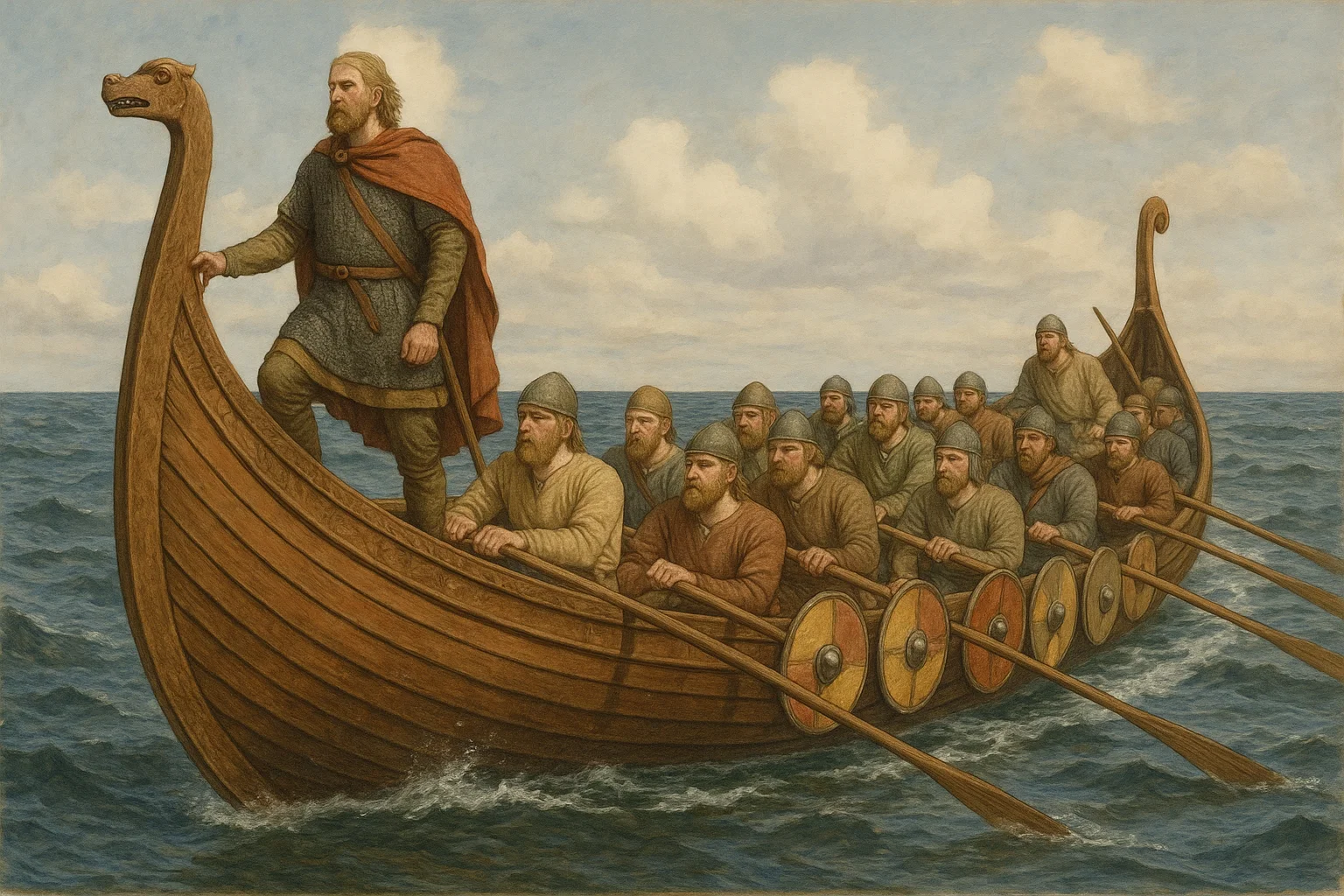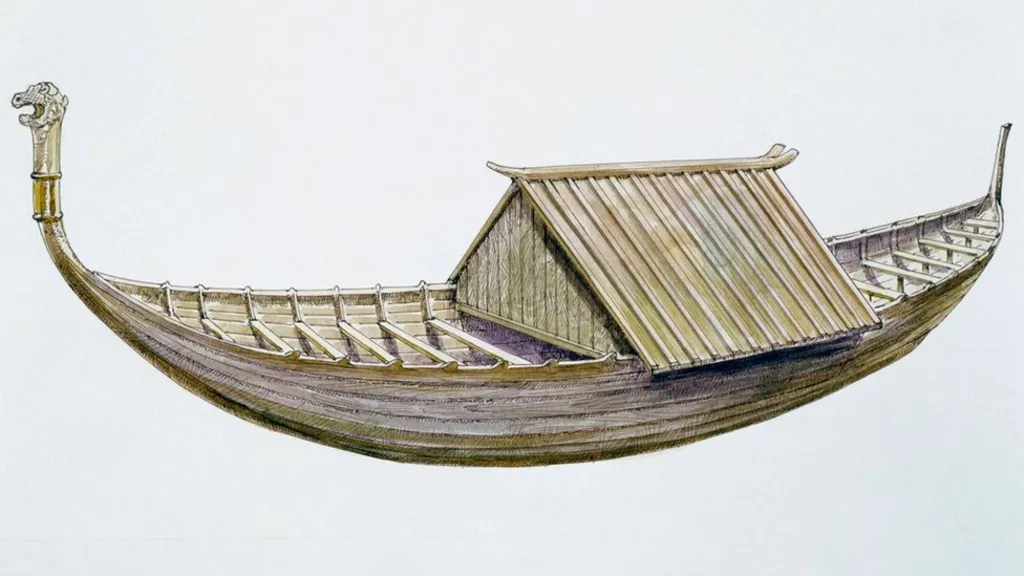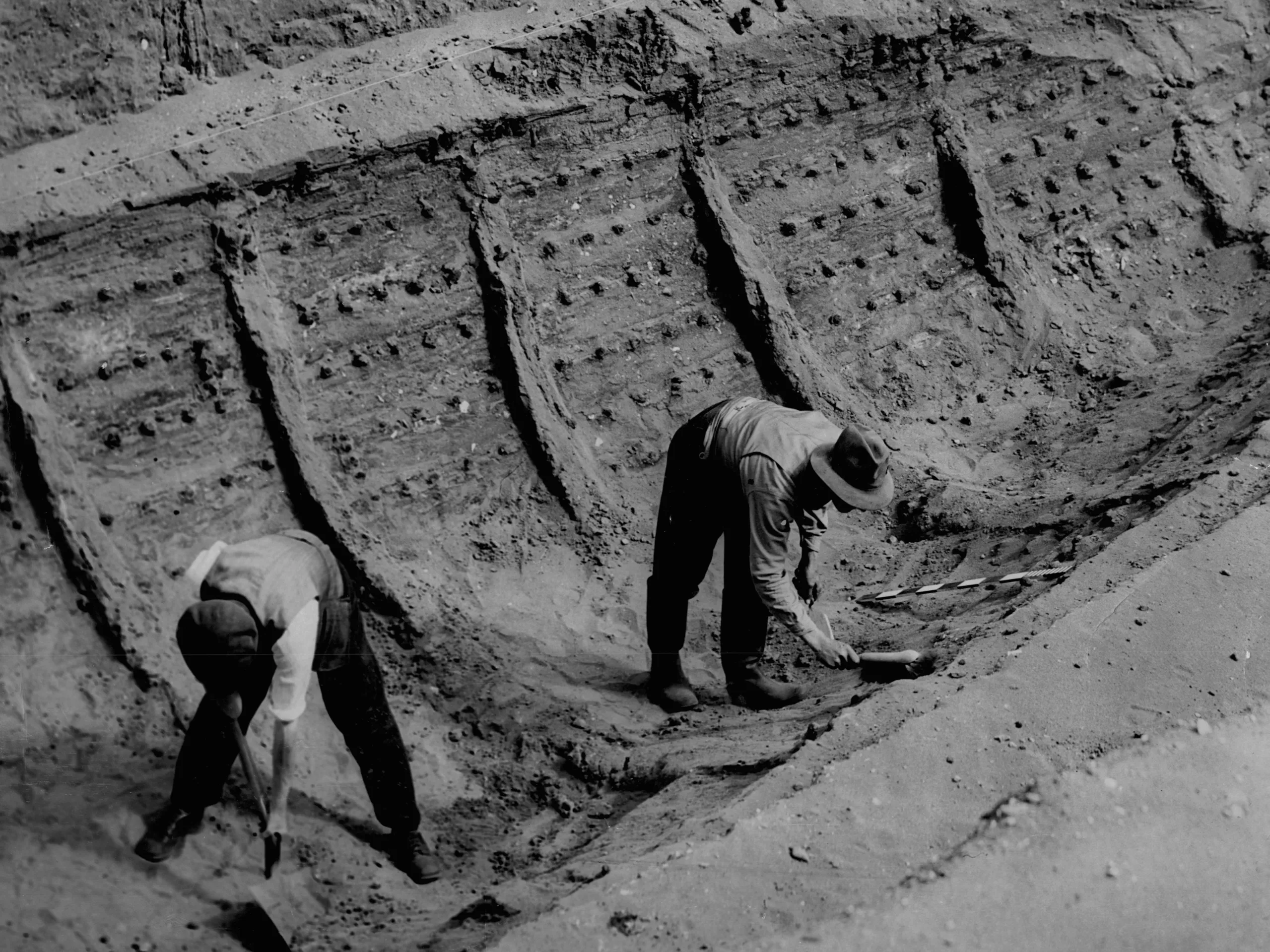Introduction
The Migration Period (4th to 9th centuries AD) was a formative era for shipbuilding in Northern Europe. Long, narrow wooden boats – commonly called longboats or longships – were vital for the seafaring and riverine activities of various Germanic and other North European peoples. Groups such as the Frisians, Angles, Saxons, Jutes, Danes, and others (including Norse Scandinavians, Slavs, and Franks) all utilized boats for migration, trade, warfare, and exploration across the North Sea and inland waterways.1
These vessels allowed the Anglo-Saxons to cross the North Sea into Britain, enabled Frisian merchants to dominate coastal trade, and carried Scandinavian raiders along coasts and deep up rivers. Our understanding of these craft comes from a combination of archaeological finds (e.g. ship burials and bog finds), experimental reconstructions, and contemporary accounts.2
Dimensions and Layout
Early medieval longboats varied in size from modest river craft to impressive seagoing warships. A hallmark example is the Nydam oak boat (c. 310–320 AD) from Denmark, which measures about 23 m in length and 3.5 m in beam. This large rowing vessel had 14 pairs of oars (28 oars total) and could carry an estimated crew of 40–45 men.3
In England, the Anglo-Saxon Sutton Hoo ship (early 7th century) was even longer – roughly 27 m long and 4.4 m wide amidships – with pointed bow and stern rising high, and about 20 rowing positions per side. These dimensions indicate a capacity for around 40 oarsmen, suggesting crews on the order of 40–60 including any additional passengers or warriors.4

Archaeological excavation of the Sutton Hoo ship burial from early 7th century England. Though the wood of the ship had completely rotted away, the impression and pattern of iron rivets in the soil allowed archaeologists to determine its dimensions and construction techniques. This vessel represented the pinnacle of Anglo-Saxon shipbuilding technology.
By contrast, some vessels in Scandinavian boat graves were smaller, on the order of 9–10 m long, used for burying high-status individuals with weapons and goods. This range in sizes shows that Migration-period longboats were built for different purposes: from small riverine transports to large seafaring troop carriers.5
Despite differences in scale, these boats shared a similar layout. Most were double-ended – that is, symmetric with a pointed prow and stern – which allowed quick beach landings and departures without needing to turn around. The hulls were open (undecked) or only partially decked, providing a single continuous interior space for rowers, cargo, or passengers.6
For example, the Sutton Hoo ship's wood had rotted away, but the pattern of rivets and stains in the sand show an open hull reinforced by 26 wooden ribs, with no fixed deck and no deep keel present. Instead of a high keel, the boat had a broad, flat keel plank along the bottom, contributing to a shallow draft ideal for beaching and shallow waters.7
Crosswise thwarts or benches would have provided seating for oarsmen. Oar ports or thole pins along the gunwales (such as the thorn-shaped oar rests on the Sutton Hoo ship) indicate the rowing positions. Steering was usually accomplished with a single large steering oar or "rudder" attached to one side of the stern.8
There was no permanent mast in the earlier boats – they were primarily rowed vessels. The Nydam ship, for instance, is "the earliest rowed true longship" known, built around 350 AD with no evidence of a sail. Its underwater hull was rounded with flared topsides, a shape that added stability and helped keep out waves at speed.9
Only toward the end of this period did some longboats begin to carry sails (discussed below). Overall, the long, narrow layout with high curving stem and stern provided both practicality (speed, maneuverability, beachability) and an imposing presence in the water.
Construction Materials and Techniques
Northern European shipwrights of the Migration Period employed a consistent set of materials and building methods, adapting ancient boatbuilding traditions to new needs. Timber was the primary material – especially oak, which was favored for its strength and durability. The Oseberg ship (Norway, c. 820 AD) was built almost entirely of oak planks, and the Nydam oak boat similarly used massive oak timbers.10

Artist's reconstruction of a Migration Period longboat with covered central section, showing the characteristic curved hull and high prow and stern. Such vessels were common among Frisian and Anglo-Saxon seafarers in the 5th-7th centuries, featuring clinker-built construction that would later evolve into Viking vessels.
In some cases other woods like pine or spruce were used for smaller boats or specific parts (indeed a second, smaller boat about 19 m long found at Nydam was made of pine). Large oak trunks were split into planks using axes and wedges, yielding strong curved strakes (planks) that formed the hull.11
Iron was also crucial to construction – specifically, iron rivets or clench bolts were used to fasten the overlapping planks in what is known as clinker construction. In clinker (or lapstrake) technique, each plank's lower edge overlaps the upper edge of the one below it, and they are riveted together through the overlap. Archaeologist Conrad Engelhardt noted that the Nydam find included two "intact clinker-built boats" – clear evidence that this method was established by the 4th century.12
The Sutton Hoo ship's imprint likewise showed it was built "clinker-fashion" with iron rivets securing nine planks on each side of the keel plank. This overlapping plank design, common across the North Sea cultures, produced a lightweight yet sturdy hull that could flex in waves. It was the dominant northern shipbuilding method (in contrast, Mediterranean ships tended to use a carvel technique with edge-to-edge planks).13
Inside the hull, frames and ribs provided support, though their installation evolved over time. Early Germanic boats sometimes had light internal framing that was lashed or pegged rather than rigidly fastened. Notably, the Nydam oak boat's interior shows that its frames were "adjusted to planks by spacers and fixed by ropes" rather than being treenailed or bolted.14
This recalls even earlier Iron Age craft (like the Hjortspring boat of 3rd century BC Denmark) which had sewn-plank construction. By the early Middle Ages, shipwrights began securing frames more solidly. The Sutton Hoo ship's 26 ribs were probably trenailed or clamped to the planking (the wood didn't survive, but iron clamps have been found in some contemporary boat burials). The overall structure remained shell-first: the hull planks were assembled and riveted into a self-supporting "shell," after which frames were inserted for rigidity.15
The Introduction of the Sail
Another major innovation during this period was the introduction of the sail and supporting mast. For most of the Migration Period, longboats were oar-propelled; rowing provided reliable maneuvering in the fickle winds of the North Sea. However, by the 7th to 8th centuries evidence for sailing rigs appears.16
A ship find from Kvalsund, Norway (c. late 7th century) included what is likely a mast step, indicating a mast-mounted sail was used. The famed Oseberg ship is "the oldest one equipped with a mast and sail" yet found – it carried a mast about 9–10 m tall and a large woolen sail of roughly 90 m².17
Fittings like chain-plates for shrouds (side ropes stabilizing the mast) and an iron anchor were part of the Oseberg's equipment, showing the technological advances that came with sail power. To support a mast, builders had to modify the longboat design slightly: adding a stout keelson or mast partner to distribute the mast's load and perhaps strengthening the keel.18
Even so, the mast was likely removable – the Oseberg and later Viking ships could strike (take down) the mast when rowing or during rough seas. By the end of the 9th century, the longboat had fully transformed into the classic Viking longship: a clinker-built oak vessel, propelled by both oars and sail, capable of ocean voyages. This evolution was a direct outgrowth of the experiments and refinements made in the Migration Period.19
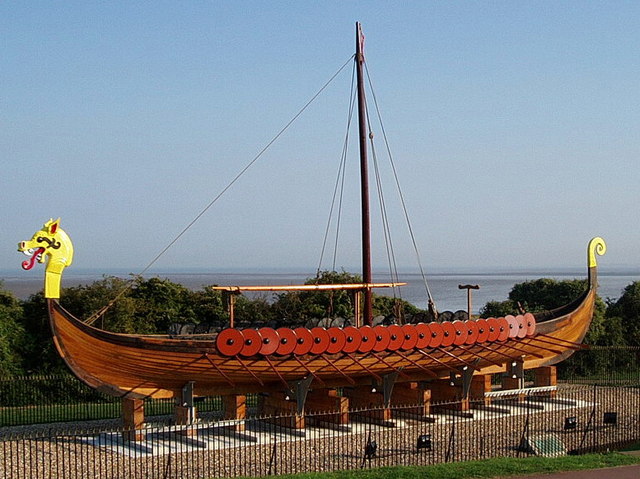
Environmental Adaptation
One reason for the longevity of the clinker longboat design was its superb adaptation to the varied environments of Northern Europe. These boats had to perform in two very different settings – the open sea and shallow inland waters – and the design struck a balance between them.20
A defining feature was the shallow draft of longboats. With their broad but relatively flat bottoms and lack of a deep keel, they drew very little water (a typical 17 m war-boat might draw only ~0.5 m). This enabled crucial flexibility: ships could be sailed or rowed right up onto beaches and riverbanks, and they could navigate inlets, estuaries, and rivers that were off-limits to deep-keeled vessels.21
The lightweight construction meant a longboat could even be hauled over land when necessary. Historical accounts from the Viking Age describe crews portaging their ships between rivers. Indeed, a well-built longship was "so light that it had no need of ports – it could simply be beached, and even carried across a portage." This portability was invaluable for raiding parties and migrants alike, allowing rapid movement through the "watery highways" of Europe.22
For seafaring in the North Sea and North Atlantic, the boats needed to handle choppy waters and wind. The longboats' hull form addressed this: the clinker-plank construction provided a bit of flexibility, acting like a shock absorber against waves, and the upward flare of the hull's sides helped deflect spray.23
The Nydam ship's design, for example, with rounded bottom and flared sides, gave it more stability and kept water out better at speed or in waves. The high prow and stern on many of these boats were not just ornamental – they helped cut through waves and reduced swamping in rough seas.24
As the Viking-era ships introduced sails, some regional variation emerged in hull shape for different conditions. The Norwegians, who ventured into the rough North Atlantic, built some ships slightly deeper and sturdier (greater draught), whereas Danish and Frisian vessels, used in calmer seas and shallow coasts, were relatively flatter-bottomed.25
A later Viking classification speaks of Norwegian ships versus Danish ships, the latter designed for the low, sandy coasts and easier beaching. Such differences likely already had roots in the Migration Period – for instance, boats along the Frisian and Saxon North Sea coast may have emphasized shallow draft to deal with tidal flats, while those in Scandinavian fjords needed to be more robust for open water.26
Inland Navigation and Local Craft
Inland, the longboats were often accompanied by or substituted with simpler craft on narrow rivers. Many Germanic and Slavic communities used dugout canoes (hollowed single logs, also called monoxyla) for upstream travel and local transport.27
The Norse "Rus'" traders in Eastern Europe, for example, were described as traveling in monoxyla – "simple boats made from hollowed out trees or carved from flat-bottomed pieces of wood" – down the Dnieper toward Constantinople. These could be built quickly and were light enough to carry around river obstacles.28
Such logboats lacked the capacity and speed of the large plank-built longboats, but they excelled in very shallow streams and could be produced from a single large tree. There is evidence that Viking raiding parties would build or acquire dugouts for riverine legs of their journeys, or even convert old longships into river craft by removing the mast and reducing draft.29
In the marshy, canal-laced landscapes (like around Frisia or the Baltic Slavs' territory), flat-bottomed punts and barges were also used for transport. Overall, the Migration-period seafarers showed ingenuity in matching their vessels to the environment – whether by sailing the high seas in stout longships, hugging coasts and estuaries in shallow-draft boats, or paddling upriver in a dugout canoe, they leveraged design features to thrive in each context.30
Cultural Significance
Longboats were more than just vehicles; they were central to the culture and identity of the societies that built them. For coastal peoples like the Frisians, Angles, Saxons, and Scandinavians, ships represented power, prestige, and connection to ancestors. This importance is evident in their prominent place in art, literature, and burial customs.31
Ship burials – where deceased leaders were interred in actual boats – represent one of the most dramatic expressions of this cultural significance. The Sutton Hoo ship burial (c. 625 AD) in Suffolk, England contained not just a magnificent longship but also an extraordinary wealth of grave goods, including weapons, jewelry, and items from as far away as Byzantium. This burial, likely of King Rædwald of East Anglia, shows the Anglo-Saxon reverence for ships as symbolic of a leader's journey to the afterlife.32
Similarly, Scandinavian ship burials at Oseberg, Gokstad, and other sites demonstrate this practice continued through the later period. The effort required to haul a large ship onto land and bury it under a mound reveals the immense symbolic value these vessels held. In the case of the Oseberg ship, the burial included two high-status women along with elaborate grave goods like sledges, carts, beds, and kitchen equipment.33
Ships also featured prominently in art. The Gotland picture stones (7th-11th centuries) from Sweden depict numerous ships with their distinctive prows and sails, often in scenes involving journeys or mythological themes. Bronze and silver models of ships have been found in Anglo-Saxon and Scandinavian contexts, suggesting they may have held religious or ceremonial significance.34
In literary sources like Beowulf (c. 8th-11th century), ships are described in reverential terms, often with poetic kennings like "wave-traverser" or "sea-steed." The protagonist Beowulf's arrival in Denmark is framed by detailed descriptions of his vessel. The Old English poem itself refers to a ship-funeral for the legendary king Scyld Scefing, who is said to have originally arrived as a child in a boat and then to have been returned to the sea in a treasure-laden ship after death – a motif that suggests the mystical significance of vessels in Germanic culture.35
The longboat also served as a potent political symbol. The ability to commission and maintain a substantial warship indicated a leader's wealth and power. Some sources suggest that communities had obligations to provide ships for their king or lord – a precursor to the later system of ship-service. Ownership of a large vessel implied command of both material resources and the loyalty of a crew – both central to political authority in early medieval Northern Europe.36
Anglo-Frisian Maritime Connections
The North Sea was not a barrier but a highway connecting the Anglo-Saxon kingdoms with Frisia and the Continent. Historical and archaeological evidence points to robust maritime connections between these regions throughout the Migration Period and beyond.37
Trade was the primary driver of these connections. Frisian merchants were renowned for their maritime enterprise, establishing extensive trading networks across the North Sea. Archaeological finds of Frisian pottery, glassware, and coins in England, and Anglo-Saxon artifacts in Frisian terp settlements, attest to regular exchange. The similarity in boat-building traditions suggests not only trade in goods but also the sharing of maritime technology and expertise.38
Religious connections also relied on sea travel. The Christianization of Frisia was largely accomplished by Anglo-Saxon missionaries like Willibrord, who regularly crossed the North Sea. Later, pilgrims and church officials maintained these sea routes between the Anglo-Saxon kingdoms and the Continent.39
Political relationships similarly depended on maritime links. Diplomatic missions, royal marriages, and occasional conflicts all required sea crossings. The Anglo-Saxon Chronicle records numerous instances of fleets crossing the North Sea for various political purposes.40
The linguistic similarities between Old English and Old Frisian – often considered the closest related Germanic languages – reflect the sustained contact facilitated by maritime connections. These sea-links helped maintain cultural affinities between the Anglo-Saxon and Frisian peoples despite their geographical separation.41
Maritime connections also had a darker side: the sea route that had brought Anglo-Saxon settlers to Britain was later used by Viking raiders targeting both Anglo-Saxon England and Frisia. The speed and mobility of longships made these raids particularly devastating, as attackers could appear with little warning and depart before defenses could be mustered.42
Archaeological Evidence
Our understanding of Migration Period longboats comes primarily from archaeological discoveries. These finds can be grouped into several categories, each offering different insights into early medieval shipbuilding.43
Ship Burials
Ship burials provide some of the most complete examples of early medieval vessels. The Sutton Hoo ship burial (c. 625 AD) in Suffolk, England, though the wooden hull had completely decomposed, left a detailed impression in the sandy soil, with iron rivets marking the plank lines. From this "ghost ship," archaeologists could determine the vessel was about 27 meters long, had nine strakes (planks) on each side, and used overlapping clinker construction.44
In Scandinavia, the Oseberg ship (c. 820 AD), Gokstad ship (c. 890 AD), and Tune ship (c. 910 AD) from Norway represent the culmination of the shipbuilding tradition that began in the Migration Period. These vessels were preserved in clay-rich soil that inhibited decay, allowing modern scholars to study their construction in exceptional detail.45
Bog Finds
The Nydam boat, discovered in a bog in Schleswig (modern Denmark/Germany border region) in 1863, is one of the earliest well-preserved Germanic longboats, dating to around 310-320 AD. This 23-meter oak vessel, built for 30 oarsmen, demonstrated sophisticated clinker construction techniques already in use by the 4th century. The anaerobic conditions of the bog preserved much of the wooden structure.46
The boat was likely a war vessel and appears to have been intentionally deposited in the bog as part of a weapons sacrifice – spears, shields, and other military equipment were found alongside it. Together with a second, smaller pine boat found at the same site, the Nydam boats provide crucial insights into pre-Viking ship technology.47
Harbor and Settlement Finds
Excavations at trading centers and harbors have yielded fragments of vessels and shipbuilding debris. Dorestad, a major Frisian trading center near the Rhine, has produced ship timbers and nautical equipment from the 7th-9th centuries. Similar finds from Ribe (Denmark), Hedeby (Germany), and various Anglo-Saxon coastal sites help fill in the picture of everyday vessels that were not preserved in burials.48
At Ribe, archaeologists found traces of a boatyard with tool marks on discarded timber pieces, giving insights into shipbuilding techniques. At the trading center of Hedeby, thousands of iron rivets of the type used in clinker-built ships have been recovered.49
Iconographic Evidence
Contemporary depictions of ships provide additional information about their appearance and use. The Gotland picture stones from Sweden show numerous vessels with high, curved prows and sterns, sometimes with sail and rigging details. The Bayeux Tapestry (11th century), though later than our period, depicts ship construction and sea crossings that likely reflect traditions established in earlier centuries.50
Ship graffiti scratched on objects or church walls occasionally survive from the period, giving glimpses of how these vessels were perceived by those who used them.51
Together, these archaeological sources allow us to reconstruct a remarkably detailed picture of Migration Period maritime technology, from the materials and methods used in construction to the evolving design features that made these vessels so effective in their North Sea environment.52
Legacy and Evolution
The longboats of the Migration Period represent a critical stage in Northern European maritime technology. They bridged the gap between earlier prehistoric vessels and the later, more famous Viking longships. Their development was not a revolution but a gradual evolution, with each generation of shipwrights making incremental improvements to designs passed down from their predecessors.53
The clinker-built tradition that defined these vessels continued well beyond the Migration Period. Viking-era ships like the Gokstad and Skuldelev vessels were direct descendants of the Sutton Hoo and Nydam boats, sharing the same basic construction principles while incorporating refinements like more sophisticated sail rigs and stronger keels.54
Even after the Viking Age, medieval ships in Northern Europe continued to use clinker construction for centuries. The 13th-century Bremen cog, though representing a different tradition with more cargo capacity, still shows the influence of earlier shipbuilding methods. Only in the later medieval period did northern European shipbuilders begin to adopt the carvel (smooth-sided) construction method from the Mediterranean.55
The importance of these Migration Period vessels extends beyond their technical contributions. They made possible the Anglo-Saxon settlement of Britain, the extensive Frisian trading networks, and later the Viking expansion. In this sense, they were vessels not only for people and goods but also for culture and ideas, spreading languages, religions, artistic styles, and technologies across Northern Europe.56
Their influence can even be seen in modern boat-building traditions. The clinker-built rowing and sailing boats of the British Isles, Norway, and other North Sea regions maintain construction techniques traceable to Migration Period prototypes. The lightweight yet seaworthy qualities that made longboats successful in the 6th century remain desirable in small craft today.57
These vessels also maintain their grip on the modern imagination. Reconstructions like the Sea Stallion of Glendalough (based on a Viking-era ship but representing the culmination of Migration Period design principles) have made experimental voyages across the North Sea, demonstrating the seaworthiness of these ancient designs and providing insights into the maritime skills of early medieval seafarers.58
Connection to Longhouses
An intriguing parallel exists between the longboats discussed in this article and the longhouses of early medieval Northern Europe. Both represent signature adaptations to the North Sea environment by the same cultures, and they share not only conceptual similarities but also constructional features.59
The most obvious similarity is in their elongated form and structural approach. Both longhouses and longboats used timber framing with supporting posts/ribs and exterior covering (planks or wattle-and-daub). In both, the internal space was organized linearly, with specialized zones for different activities.60
Several construction techniques appear in both traditions. The use of radially-split oak, careful selection of curved timbers for specific parts, and certain joinery methods are common to both boatbuilding and house construction. Archaeological evidence from sites like Wijnaldum and Ribe shows that the same tools were often used for both crafts.61
Symbolically, both structures represented shelter and conveyance - the house providing shelter on land, the boat offering a mobile "house" on water. This connection is made explicit in some burial customs, where the ship becomes the final "house" of the deceased. The ship-like appearance of some longhouse roofs (inverted hull shape) and the house-like aspects of boat coverings suggest a conceptual link between the two forms.62
In practical terms, the same communities that built longhouses like those found in Frisia and Anglo-Saxon England also constructed the boats that maintained connections between them. The cultural significance of both forms likely reinforced each other – the longhouse as the center of daily life, the longboat as the means of connection to the wider world.63
Flat-Bottomed Legacy: From Longboats to Regional Vessels
When examining the evolution of ship design in the North Sea region, striking connections emerge between the Migration Period longboats and later traditional vessels across the former Anglo-Frisian territories – particularly evident in flat-bottomed craft designed for shallow waters and tidal environments. These connections represent direct lines of continuity between early medieval maritime technology and more recent historical watercraft.67
The Frisian Skûtje
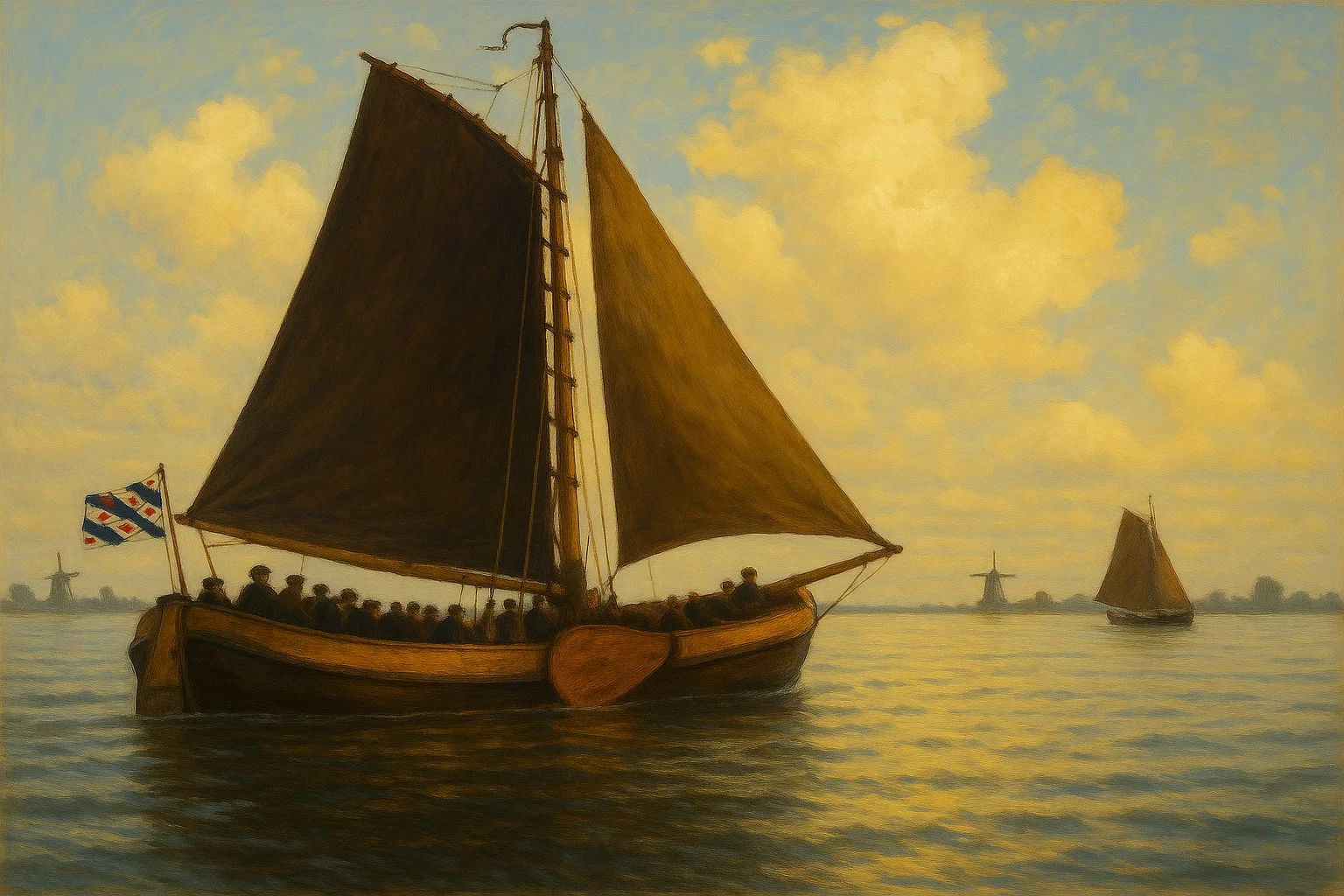
The Frisian Skûtje (also known as Skutsje), which became prominent from the 17th-19th centuries, bears remarkable similarities to its ancient predecessors despite the passage of nearly a millennium. Most notably, the shallow-draft design principle that made Migration Period vessels so versatile in shallow coastal waters and tidal flats remained central to Skûtje construction. These flat-bottomed sailing barges were perfectly adapted to the shallow waters of the Frisian coast, lakes, and canals – an environmental adaptation directly parallel to that of early Frisian ships.68
Though later Skûtjes used carvel rather than clinker construction (with planks laid edge-to-edge rather than overlapping), they maintained many structural elements descended from earlier traditions: the emphasis on oak timber, the curved stem and stern posts, and proportions that balanced carrying capacity with maneuverability. The lee-boards (side-mounted boards that could be lowered to prevent sideways drift) that became characteristic of Skûtjes represented an innovation that addressed the same challenge that the shallow keel of longboats had attempted to solve – maintaining course while preserving shallow draft.69
The Skûtje's role in Frisian society also echoed the cultural importance of its predecessors. Just as Migration Period longboats had been central to Frisian identity as traders and mariners, the Skûtje became a symbol of Frisian maritime heritage. The traditional Skûtsjesilen racing competitions, which continue to this day, celebrate this connection to a seafaring past that stretches back to the early medieval period.70
Norfolk Wherries and the Broads
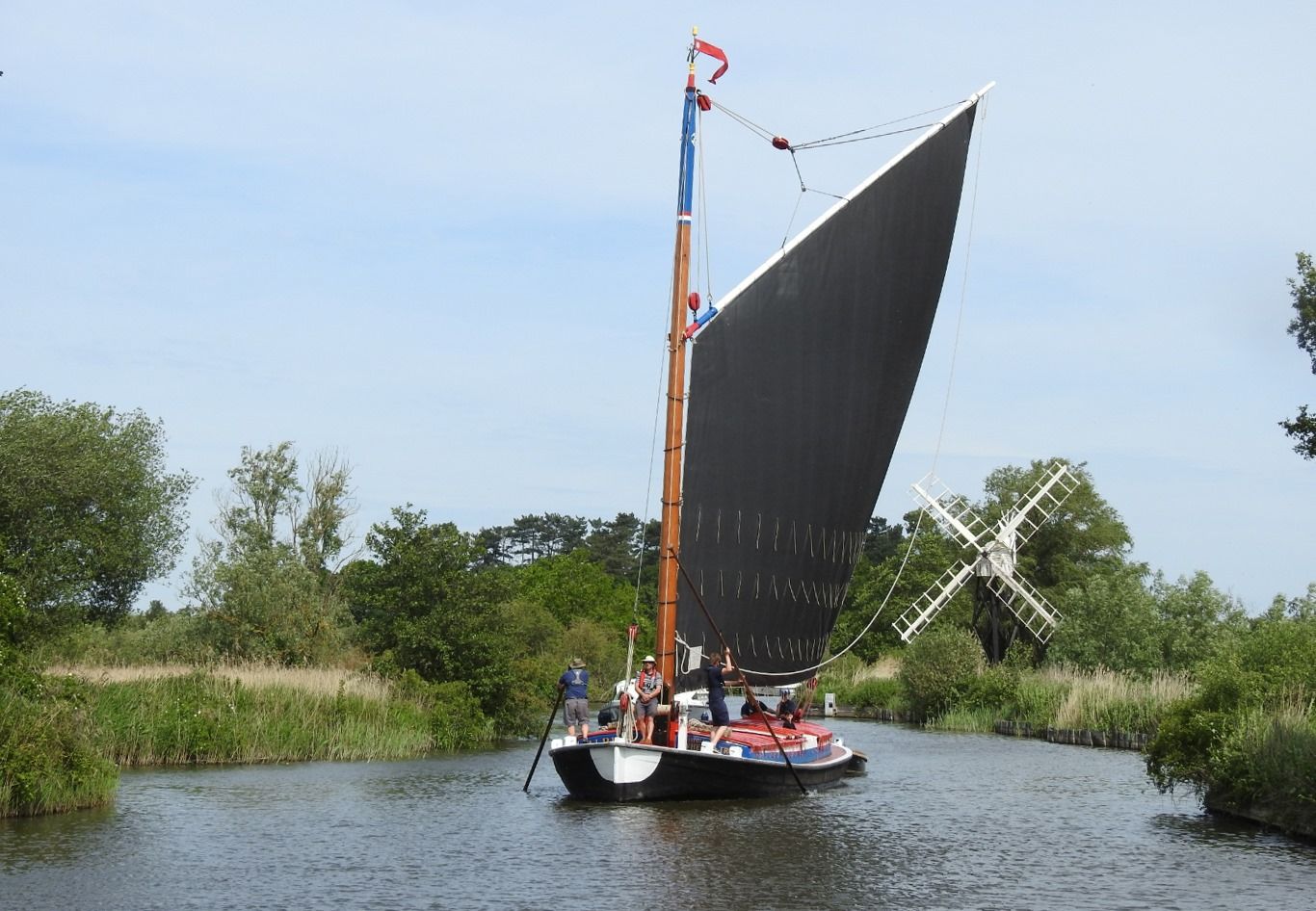
In East Anglia, particularly in Norfolk, a parallel tradition developed with the Norfolk Wherry – a distinctive flat-bottomed sailing barge that shares remarkable similarities with both the Frisian Skûtje and, by extension, elements of the earlier Anglo-Saxon vessels. These black-sailed trading vessels were perfectly adapted to the shallow waters and narrow channels of the Norfolk Broads and rivers.71
Like the early longboats and the Frisian Skûtje, wherries featured a shallow draft design (typically less than 1 meter) that allowed navigation in the shallow, interconnected waterways of East Anglia. Their single mast and large sail could be lowered to pass under bridges, an adaptation comparable to the striking of masts in earlier vessels. Most intriguingly, historical evidence suggests that the wherry design evolved from earlier medieval boat traditions in an area that had received significant Anglian and Frisian settlement during the Migration Period.72
The regional specificity of the Norfolk Wherry mirrors the environmental adaptations seen in both Migration Period longboats and Frisian craft – a convergent evolution driven by similar maritime needs. The black sails, often treated with tar for weatherproofing, became as iconic to Norfolk maritime identity as the wooden construction was to Frisian cultural heritage.73
Danish Coastal Vessels
In Denmark, which shares the North Sea coastline with Frisia and England, we find another parallel in the traditional fishing vessels of Jutland, particularly the Sjægt – a flat-bottomed fishing boat used in the shallow waters of the Limfjord. These vessels, like their Frisian and East Anglian counterparts, feature the shallow draft necessary for tidal flats and protected bays.74
Though smaller than trading vessels, the Sjægt and related Danish craft show a similar pattern of adaptation to local conditions while maintaining design elements traceable to earlier seafaring traditions. The continued use of clinker construction in many Danish boats, even after it had been replaced by carvel techniques elsewhere, suggests a stronger preservation of earlier shipbuilding methods in this region.75
This pattern of persistent regional boat-building traditions across the former territories of Anglo-Frisian and Danish settlement reflects the remarkable stability of certain aspects of maritime culture despite political, religious, and economic changes over the centuries. The persistence of design elements suited to the particular challenges of the North Sea environments demonstrates how deeply maritime technology was embedded in regional identities and practical knowledge.76
Conclusion
The longboats of the Migration Period represent one of the most successful adaptations to the maritime environment in pre-modern Europe. Through their blend of light weight, strength, flexibility, and shallow draft, they perfectly suited the needs of the Germanic peoples who built and used them. From the humble river craft of local communities to the impressive war vessels of kings and chieftains, these wooden ships made possible the movements of people, goods, and ideas that shaped early medieval Northern Europe.77
What makes these vessels particularly remarkable is how they embodied cultural continuity while facilitating change. Their construction methods were passed down across generations, yet they were constantly refined and adapted to new challenges and opportunities. The longboat that carried Anglo-Saxon settlers to Britain in the 5th century evolved into the vessel that carried Norse raiders to the same shores three centuries later – and elements of its design survived in vessels like the Frisian Skûtje, Norfolk Wherry, and Danish Sjægt for centuries beyond.78
In studying these ships, we gain insight not only into the technical accomplishments of early medieval shipwrights but also into the societies they served. The resources required to build them, the skills needed to sail them, and the purposes for which they were used all illuminate aspects of Migration Period life that might otherwise remain obscure.79
The story of Migration Period longboats is thus a story of human ingenuity applied to the challenges of living in the North Sea world – a testament to how these early medieval peoples mastered their environment through observation, experimentation, and the preservation and refinement of hard-won knowledge.80
